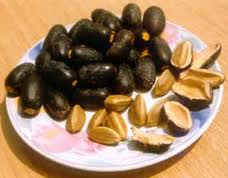The Centre has been a resounding success, caring for almost 1,000 endangered mammals, birds and reptiles from dozens of different species. However it is the orang utan rehabilitation programme that has made the Centre famous. In one respect, Semenggoh has been too successful – so many orang utan have been successfully reintroduced into the surrounding forest reserve that the forest’s carrying capacity has been reached, and rehabilitation activities have been transferred to the Matang Wildlife Centre, part of Kubah National Park.
As a result of its success, Semenggoh’s
role has changed and it is nowadays a centre
for the study of orang utan biology and behaviour,
as well as a safe and natural haven for dozens
of semi-wild orang utan, graduates of the rehabilitation
programme. It is also home to numerous baby
orang utan, born in the wild to rehabilitated
mothers.
A visit to Semenggoh is a once in a lifetime
experience is a chance to see semi-wild orang
utan, ranging from tiny infants and boisterous
adolescents to dignified mature adults, enjoying
life in a secure natural habitat. You will really enjoy when you visit the Semenggoh Wildlife Centre.
The best time to visit Semenggoh is during the morning and afternoon feeding sessions when there is a good chance of seeing semi-wild orang utan returning to the Centre for a free meal. Feeding takes place between 9.00-10.00am and between 3.00-3.30 pm.
In addition to the orang utan, visitors will be able to see other endangered species at Semenggoh. The centre’s wildlife population varies, so it is difficult to say exactly what animals you may encounter on your visit. However, the centre has housed a wide range of wildlife, including rescued gibbons, porcupines, crocodiles and river terrapins. In the surrounding forest you will certainly hear the cries of rehabilitated gibbons, as well as the songs of a host of wild bird species. Brightly coloured lizards and various species of squirrel are also frequently encountered.





































